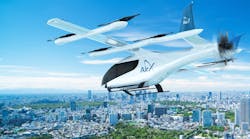by John Rhea
WASHINGTON — "Why can't we buy just one aeroplane and let the aviators take turns flying it?" mused President Calvin Coolidge in 1928, when the U.S. Army hit him up for $25,000 for an entire squadron of military aircraft.
It may yet come to that. Three fighter aircraft with daunting per-copy price tags are contending for a package of post-Cold War combat missions. When the music stops, there may only be chairs for two. Or one. Or none.
One of the three candidates encompasses an upgrade of the existing airframe and evolutionary improvements to the avionics and other subsystems: the U.S. Navy's F/A-18 E/F Super Hornet currently in advanced development by Boeing's St. Louis operations and undergoing flight tests at the Navy's Patuxent River Naval Air Station in Maryland.
The other two represent relatively clean-sheet-of-paper designs capable of absorbing more advanced avionics. The first is the U.S. Air Force's F-22 Raptor, from Bethesda, Md.-based Lockheed Martin Corp. The second is the Joint Strike Fighter (JSF), which leaders of the U.S. Air Force, Navy, and Marine Corps, as well as British forces, plan to buy. Boeing and Lockheed Martin are scheduled for a head-to-head flyoff this fall at Patuxent River.
What the three fighter aircraft programs have in common is staggering program unit costs that are far beyond those of the present generation consisting of the Air Force's F-16, the Navy's original F/A-18, and their top-of-the-line predecessors, the Air Force's F-15 and the Navy's F-14.
Budget experts estimate the F-22 will cost about $125 million apiece for 339 aircraft, or a total of about $48 billion, a considerable difference from the $35 million a copy for 750 aircraft that the Air Force quoted when the program was approved in 1985. The Air Force and Navy together want about 2,800 JSFs at around $70 million each, or nearly $200 billion for the total buy. By contrast, the Super Hornet looks to be a bargain. The Navy wants to buy the first 222 this year for nearly $9 billion, or about $40 million each, and buy a total of 548 over the next 12 years.
What the aircraft don't have in common is a common avionics suite, and that was one of the goals when experts first formulated the idea of the F-22 in the 1970s under the designation Advanced Tactical Fighter, or ATF. The idea was that by sharing avionics down to the board level with the Army and Navy all three services could cut costs and implement new technologies more rapidly. This never happened.
To be fair to the Air Force, the service was rather left hung out on the line to dry when the Navy was forced to scuttle its A-12 Advanced Tactical Aircraft, or ATA, after disastrous cost overruns and schedule slippages. Avionics commonality never materialized between the ATA and what was then the Army's Light Helicopter-Experimental, or LHX, which since has become the RAH-66 Comanche scout-attack helicopter.
Thus the idea of a common ATF-ATA-LHX avionics suite literally never got off the ground. Given the relatively high cost of avionics as a portion of flyaway costs — at least 30 percent across the board for military aircraft and generally much higher for tactical fighters — it can be argued that keeping those costs under control could have put all the tactical aircraft programs on a sounder financial footing.
Moreover, the avionics planned for that generation didn't stray far from the mainstream of preceding aircraft: 1750A airborne computer, 1553 databus, SEM-E form factor for the avionics modules, and the rest. There weren't many marks on the clean sheets of paper.
In the case of the F-22, a big portion of the $125 million price tag goes instead into aerodynamics and propulsion improvements, such as the ability to cruise at supersonic speeds without using its afterburner. Stealth capabilities are improved somewhat over current aircraft, but the F-22's primary mission is to achieve air superiority over as-yet ill-defined foreign threats such as the Russian Su-35 and the EF-2000 Eurofighter. This appears increasingly like a solution looking for a problem.
Michael O'Hanlon, an analyst at the Washington-based Brookings Institution, questions not only the necessity of the F-22 to maintain U.S. air dominance, but also the Air Force's assertion that the aircraft is necessary to knock out increasingly more formidable surface-to-air missile (SAM) systems, such as Russia's SA-10, which have phased-array radars capable of tracking multiple targets and longer-range interceptor missiles. O'Hanlon suggests that unmanned combat aerial vehicles could assume much of that task.
Instead, he urges the Air Force to cut back on its planned buy of the F-22s (from 339 to 125) and JSFs (from 2,763 to 500) and reinvest the savings into upgrading the F-15s for the air superiority job and F-16s as multi-role aircraft. Other investments under his alternative would go into more airborne surveillance, precision-guided munitions, and electronic jamming aircraft.
Meanwhile, officials of the U.S. General Accounting Office are urging Congress to delay the engineering and manufacturing development (EMD) phase of the JSF program. On May 8 members of the U.S. Senate eliminated EMD money from the 2001 budget, which they are hammering out, against the wishes of U.S. Secretary of Defense William Cohen and top Air Force generals.
Given the inevitability of finite Pentagon budgets even in today's booming economy, the issue boils down to whether the services can justify these aircraft at the expense of other pressing needs. The Congressional Budget Office estimates that if the Air Force and Navy get all the aircraft they want they will be spending roughly 8 percent of their budgets on fighter procurement.
Norman Augustine, the former chairman of Martin Marietta Corp. (now part of Lockheed Martin), anticipated this impasse in 1986 in one of his famous laws, which he said was known in some circles as the First Law of Impending Doom and in other circles as the Final Law of Economic Disarmament:
"In the year 2054, the entire defense budget will purchase just one aircraft. This aircraft will have to be shared by the Air Force and Navy 3-1/2 days each per week except for leap year, when it will be made available to the Marines for the extra day."
That would have brought a smile to the face of the stoic Calvin Coolidge.


